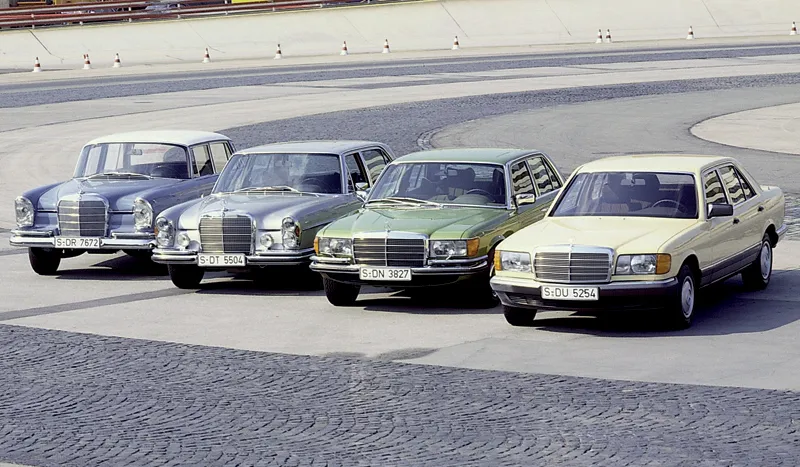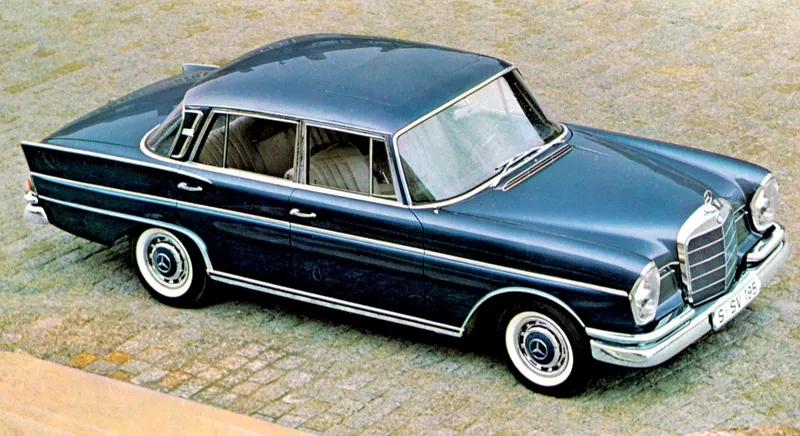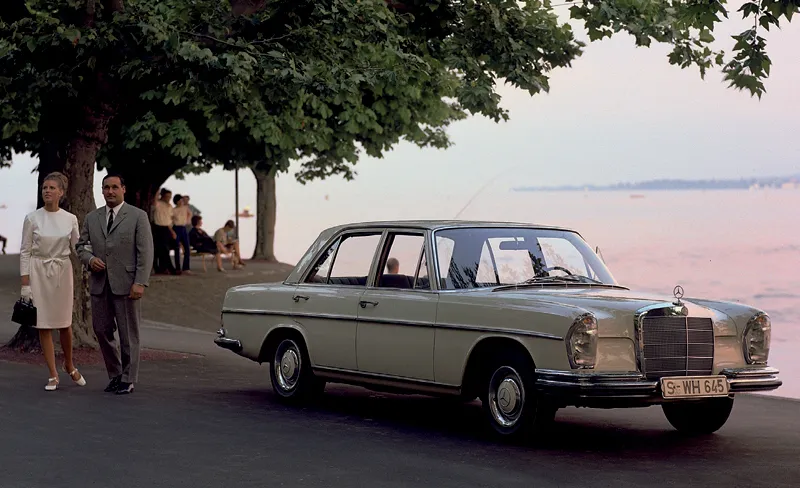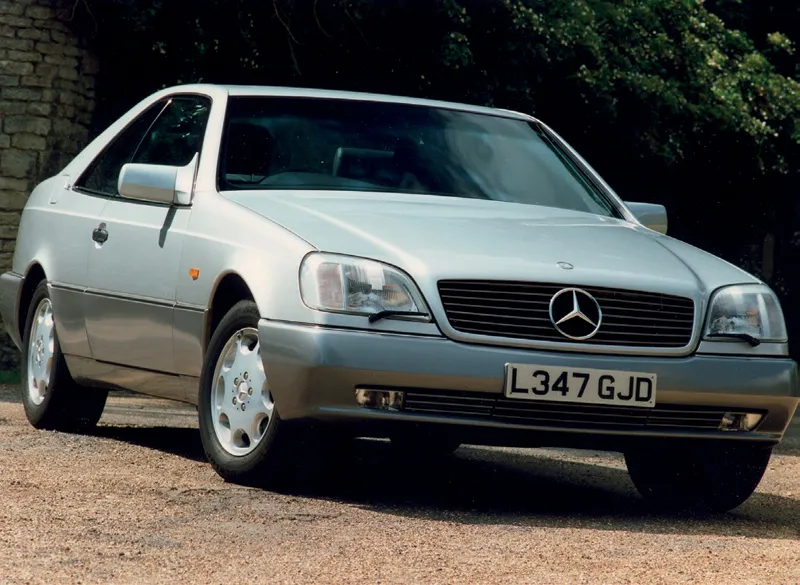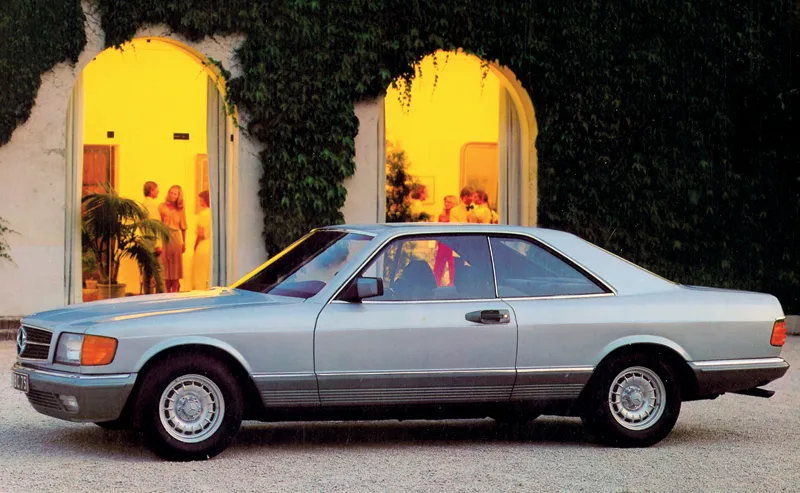![]()
CHAPTER ONE
DEFINING THE S-CLASS
The Mercedes-Benz S-Class has been a massive worldwide success story, one that is the envy of other car manufacturers. The car is almost universally regarded as the pinnacle of automotive excellence – ‘the best car in the world’, despite Rolls-Royce’s earlier use of that title – and has become a symbol of material success for its owners. It has become a benchmark of good taste in automotive design, and is seen also as a pioneer of new automotive technology of all kinds. Despite determined attempts by rival manufacturers to claim a share of the S-Class market, the car has retained its position at the pinnacle of luxury saloons for more than forty years.
That is a formidable achievement. Not content with building the most widely acknowledged automotive symbol of success, Mercedes has gone on to back it up with exclusive coupé derivatives, even more expensive and even more symbolic of material success. The sales of the S-Class have not only had a halo effect on the rest of the Mercedes marque, they have also enabled new technology to be introduced at the top end of the market while the car remains expensive – and have then managed to reduce its cost either by further development or simply by volume production, so enhancing the less expensive models in the company’s lineup as well. The business model is flawless, and those who have maintained it across five generations of the S-Class – with a sixth arriving as this book goes to press – deserve the praise that has been heaped upon them from enthusiasts and rivals alike.
This was how Mercedes saw the S-Class lineage in 1980. Far left is a ‘Fintail’ saloon; next is a W109; and then come the S-Classes proper – a green W116 and a yellow W126.
So how did the S-Class come about? When the first version, called W116 by its makers, reached the market in 1972, the Mercedes-Benz marque was making a new assault on international markets. Key among these was North America, where Mercedes models had been widely respected since the early 1950s, but where the company was still very much a bit-part player. New safety and emissions legislation introduced in the USA during the second half of the 1960s had caused enormous problems for domestic makers and importers alike, but Mercedes was determined to ‘hang on in there’. So although North American sales were not yet central to the Mercedes business plan, there was every intention of further exploiting what was then the world’s largest car market. US expectations were therefore as important in the thinking behind the original S-Class as were expectations in Africa, the Middle East and Europe.
This 1973 advertisement shows the first S-Class, the W116 (at the back of the group) in the context of its contemporaries. In the middle is the flagship SLC coupé, derived from the R107 SL roadster, and in front is the latest version of the W114 ‘stroke 8’ medium saloons introduced in 1968.
The long-wheelbase 300 SE of 1963 featured air springs, all-round disc brakes and an all-aluminium engine with fuel injection. Though essentially a top model for the ‘Fintail’ saloon range, it made clear that Mercedes was already thinking about building a better-equipped, luxury model with the latest technical innovations.
Most important, however, was that Mercedes had identified an enduring market for top-quality luxury cars, and intended to exploit it. Perhaps the first clear indication that such a market existed had been the success of the 220 SE coupé and cabriolet models introduced in 1961. In the Mercedes scheme of things, they replaced low-volume derivatives of earlier saloon ranges, but they grabbed the attention of a much wider audience. Mercedes would never admit publicly to being surprised by such a thing, but there can be little doubt that these cars helped the company to recognize that there was a readiness for the Mercedes marque among those prepared to spend more than most on their automotive transport.
Within four years Mercedes had a new model range ready to offer such customers. The range consisted entirely of saloons, which would necessarily be less expensive than the prestigious coupés and cabriolets, but which moved a step closer to them in their appeal and price. Like the coupés and cabriolets, they were actually derivatives of the then-current mid-size saloon platform, rebodied and re-engineered to suggest more prestige. They came with a choice of standard or long (limousine) wheelbases, and with either standard suspension as W108 types, or with advanced air suspension as W109s. They were a cautious first step in the direction of an autonomous ‘prestige’ saloon range, and during the mid-1960s Mercedes marketing linked them with the coupé and cabriolet models to reflect that more upmarket appeal.
Forerunner of the S-Class was the W108/W109 series, introduced in 1965. It shared much of its engineering with the earlier ‘Fintail’ saloons.
It worked extremely well. All these cars in fact had the letter S somewhere in their model designations, and this has led many writers to refer to them as the first S-Class. They were not, of course: that had yet to come. But they did show Mercedes the direction they needed to take when they came to create the first autonomous S-Class models during the later 1960s.
The Letter S
It is interesting to see where that letter S had come from and what meaning was invested in it. Before the 1939–45 war there had been several Mercedes models whose designations incorporated the letter S, but those had all been sporting models, and the S invariably stood for ‘Sport’. After the war, however, and before the Mercedes marque had re-established itself enough to risk entering the sports-car market, the letter S re-emerged with a different meaning: from 1951 it appeared on two new models derived from existing production ranges, and in each case it clearly stood for Special.
Those new models were the 170 S, a special cabriolet derivative of the core saloon range, and the 300 S, which was a coupé or cabriolet (and even roadster) derivative of the big 300 saloon range. When the Ponton saloons arrived in 1953 with a new 220 model, this was swiftly followed by a more powerful, better-equipped derivative that took the name of 220 S in 1954.
Sporting it was not, even though it did become a favourite as a long-distance rally car: the 220 S was all about adding a little more prestige at the top end of the Mercedes mainstream saloon range. It was not itself the most expensive saloon that Mercedes made, as the big 300 held that title. But the 300 was for the very wealthy, and for heads of state such as Germany’s own Konrad Adenauer, who used one so much that the car soon acquired the nickname of the Adenauer Mercedes. The 220 S was the saloon to which the man in the street could, and did, aspire.
When fuel injection reached the mainstream Mercedes range in 1958, the SE designation (Spezial Einspritzung, or Special Injection) took over at the top of the tree. And there it would remain for many years, although the letter S alone still had connotations of prestige. By this time, the suggestion of S for Special was gradually giving way to the idea of S meaning Sonderklasse, or Special Class, not least because the German maker DKW had actually called one of its cars exactly that – a DKW Sonderklasse. Mercedes did not demur, and this interpretation of the letter S would be the one that would be carried forwards into the 1960s.
The S-Class Coupés
The origins of the S-Class coupés certainly go back to those hugely successful coupés and cabriolets of the 1960s that had been based on the platform and running gear of the top-model saloons. Once the W108/W109 range had become available in 1965 and had begun to prove that there really were customers only too ready to pay for a more presti gious Mercedes-Benz saloon, the strategy must have become clear: in future there should be both an S-Class saloon range and related S-Class coupé models.
There never were any S-Class cabriolets, and that was probably the result of a historical accident. When the first-generation S-Class was being designed, motor manufacturers everywhere were convinced that the USA would sooner or later introduce new laws that forbade the sale of open cars on safety grounds. So no cabriolet was designed; and in fact, to save development time, no coupé derivative of the W116 S-Class was attempted, either. Instead, as Chapter 2 explains, a long-wheelbase coupé derivative of the SL roadster was developed in order to occupy the flagship coupé spot in the Mercedes range.
The C140 was in production for a relatively brief period, from 1992 to 1998. Though luxurious and technically advanced, it has always aroused mixed reactions.
The C126 was the first S-Class coupé, derived from the contemporary W126 saloon. It has become an enthusiasts’ favourite.
The threat to open cars had not receded by the time the second-generation S-Class cars were being developed, so again there was no open derivative on the agenda. There was a coupé derived directly from the saloon, however, and it set the pattern for those that would follow. Visually it was quite clearly related to the saloon, although it had its own distinctive styling cues and was based on a shortened platform. Mechanically it used only...

